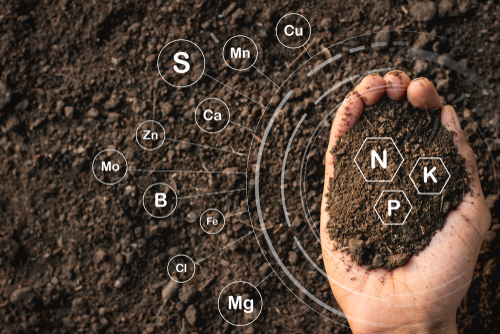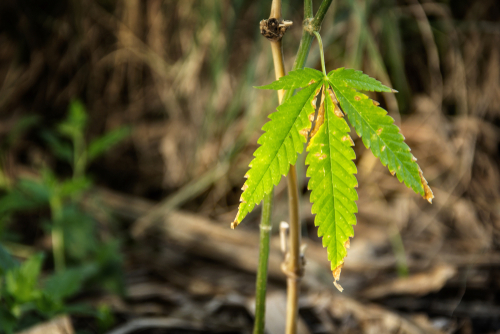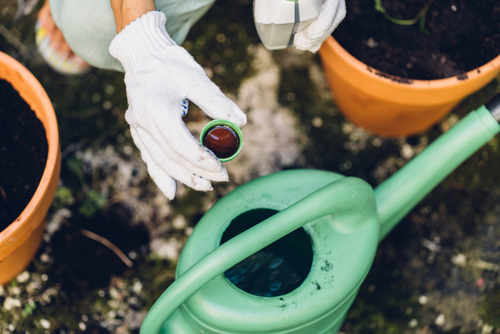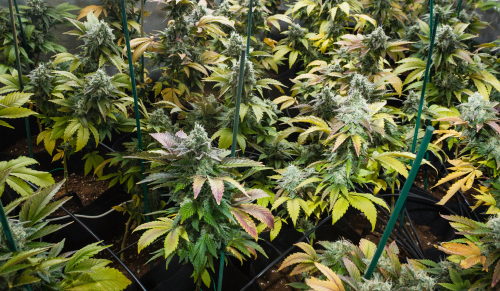Like all living organisms, cannabis plants need food to survive. The most common way cultivators “feed” their weed is by adding supplemental nutrients to their grow schedule. Colloquially called “nutes,” these powder or liquid formulas have specific ratios of chemicals and minerals for each stage of cannabis growth. When used properly, nutrients ensure cannabis strains have everything they need to grow a sturdy root system and massive buds.
Feeding Cannabis Flowers — Essential Info On Supplemental Nutrients
It’s easy for new cultivators to mishandle their nutes. Although nutrients are essential for plant growth, they can do more harm than good if growers don’t know how to use them. Before developing a feeding schedule for your flowers, be sure you understand the dos and don’ts of adding supplemental nutrients.
Why Do Cannabis Plants Need Nutrients?
Nutrients are essential for proper plant development. Although it’s possible to grow cannabis without supplemental formulas, strains won’t survive without a source of reliable food. In other words, if you’re not feeding your cannabis supplemental nutrients, they need to get enough nutrition from their grow medium. Each nutrient plays a different role in a weed’s maturity, but most support root development and energy conversion via photosynthesis.
Although cannabis plants need dozens of nutrients to thrive, only nitrogen (N), potassium (P), and phosphorus (K) are considered “essential” macronutrients. Nitrogen is vital during the vegetative stage to support the cannabis plant’s growth. By contrast, phosphorus is most in demand during flowering when strains focus their attention on producing bud sites. Because these nutrients are the most crucial for cannabis development, you will usually see the N-P-K ratios on the front of nutrient blends.
What Are The Basic Nutrient Requirements For Cannabis?
Unfortunately, it’s impossible to give a simple feeding strategy that works for every cannabis strain. Countless variables will determine the “right” amount of nutrients to feed your strains each day. However, there are a few general rules every cultivator must keep in mind when developing their nutrient schedule.
First, it’s essential to find nutrients that suit your growing medium. Nutrients for hydroponics aren’t interchangeable with soil nutrients. Always double-check that the products you’re looking into are specifically designed for your preferred growing style.

You also need to verify the N-P-K ratios in your nutrients are suitable for different stages of development. “Vegetative formulas” should have the highest concentration of nitrogen, medium amounts of potassium, and low phosphorus. By contrast, “flowering blends” need low nitrogen, medium phosphorus, and high potassium levels.
Most manufacturers list a recommended dose of nutrients on their products, but it’s best to reduce this dose by one-half if it’s your first time using it. It’s far easier to add more nutrients later than to remove too many nutrients in your soil. Aim to add nutrients every second or third watering and monitor your plants for signs of deficiencies. Hydroponics or coco coir growers may need slightly more nutrients per week since these mediums don’t have as many natural nutrients found in potting soil.
When’s The Best Time To Start Using Cannabis Nutrients?
Supplemental nutrients should only be used from mid-vegetation through the late flowering stage. Adding nutrients too early can overwhelm young plants since their root systems aren’t well-established. Cannabis seedlings can only handle mild soil formulas or specific “seed starter” solutions with gentle nutrient concentrations.
Wait until the cannabis plant has at least one set of at least four serrated fan leaves to consider adding nutrients to your weekly routine. For most photoperiod strains, you’ll need to wait about three to four weeks before using your first nutrient formula.
Can You Give Too Many Nutrients To Cannabis Plants?
It’s common for people to assume that adding more nutrients is “better” because it avoids the risks of deficiencies. Some also believe additional nutrients can’t do their plants any harm. According to this popular belief, cannabis will only absorb what it needs, and the rest will remain in the soil.
In reality, there is such a thing as “too many” nutrients. Many new cultivators struggle with overfeeding rather than underfeeding their weed. Unfortunately, using too many nutrients can disrupt the chemical balance of your grow medium and create a condition known as “nutrient burn.”

The top warning sign for nutrient burn is that the tips of fan leaves start to turn brown and curl. At the beginning of nutrient burn, the rest of the fan leaves will appear healthy and green. However, the longer you leave nutrient burn unaddressed, the more this browning will spread down your leaves.
The best way to combat nutrient burn is to put the nutrients aside and only use water for at least one week. If you notice the symptoms on your leaves improving, add your nutrients at one-third of the previous dose.
Powder vs. Liquid Nutrients — Is There A Difference?
When researching cannabis nutrients, shoppers will run across two broad categories: powders and liquids. For most of the 20th century, cultivators had to rely on liquid nutrients because they were the only ones available. However, powdered nutes are steadily gaining market share as more people investigate their unique benefits.
While there’s nothing “different” in the content of powdered and liquid nutrients, powder formulas tend to be more affordable. Since powder weighs less than water, it doesn’t cost manufacturers as much to ship them. Plus, it’s easier to combine dozens of chemicals in a powder formula rather than a water mix. Since the chemicals in liquid nutrients are already activated, manufacturers can’t add certain chemicals to the same bottle. That’s why many liquid nutrients are sold in two-part formulas, further driving up the cost of these products.

Many cultivators also appreciate the fact that powders can’t evaporate or spill. Although it takes more time to mix powders in water before adding them to a solution, countless customers are willing to trade off this inconvenience for the cost-savings they provide.
This doesn’t mean powders are more effective than liquid nutrients, but they may be unique selling points for cultivators. It’s best to try both liquid and powder nutrients formulations to see what works best for your strategy.
Are Fertilizers Enough For Weed’s Nutrient Requirements?
Cannabis can survive on natural nutrients in soil, but it takes a fair amount of time and skill to make this method work. Measuring nutrients in a “living soil” mix isn’t as precise as pouring pre-measured nutrient supplements. Anyone interested in using natural fertilizers and amendments rather than supplemental nutes should be prepared for extra trial and error.
Also, “living soil” blends will overwhelm cannabis in the early seedling phase. It’s essential to only transplant cannabis to fertilizer-rich formulations when they have a robust root system.
How Do You Tell A Cannabis Plant Has A Nutrient Deficiency?
There are countless warning signs that a cannabis plant could have a nutrient deficiency, each related to a specific nutrient. However, it’s most common that nutrient deficiencies will affect the plant’s fan leaves. Cultivators should get in the habit of monitoring their leaves’ colors regularly. If fan leaves aren’t bright green, then there’s likely something wrong going on in your plant.

Nitrogen deficiency is arguably the most common issue cannabis cultivators have with their plants. Since cannabis needs so much nitrogen during vegetation, there’s a higher chance it won’t get enough of this compound during its growth stage. The telltale sign of a nitrogen deficiency is bright yellow leaves appearing on the plant’s bottom.
A few other warning signs for specific nutrient deficiencies include:
- Magnesium: Veins of cannabis leaves start to turn yellow.
- Phosphorus: Brown spots appear on old fan leaves and move upwards.
- Potassium: Yellowing edges on fan leaves.
- Iron: Yellowing starts on new leaves near the stem rather than at the tip.
While it’s possible to see nutrient deficiencies related to other chemicals, it’s more common to see these issues in hydroponics or soilless grow mediums. Soil naturally has many of the micro and macronutrients cannabis needs to survive. Therefore, in soil mediums, it’s more likely cannabis plants have too many nutrients rather than too little.
Keep in mind that many “nutrient deficiencies” are pH imbalances. If the pH in your soil or hydroponics is off, your plants can’t properly absorb the nutrients you add to your formula. It’s imperative to keep the pH between 6 – 7 for soil and 5.5 – 6.8 in hydroponics at all times.
Final Tip: Don’t Forget To Flush Your Nutrients After Flowering!
There’s considerable debate over the merits of “flushing” cannabis plants before harvest, but some cultivators believe this simple step enhances weed’s taste and “smoothness.” As a bonus, flushing cannabis can save you significant money. Since this strategy involves switching to an all-water diet, you can save money on nutrients. Research reveals that flushed and non-flushed cannabis plants have the same expected yields, which means you don’t have to use as much of your supplements.
While flushing isn’t essential, it’s worth experimenting with at the end of your grow cycle. For soil growers, start flushing about two weeks before you expect to harvest your buds. By the way, you can learn more about when to harvest cannabis in this previous post.

Leave a Reply